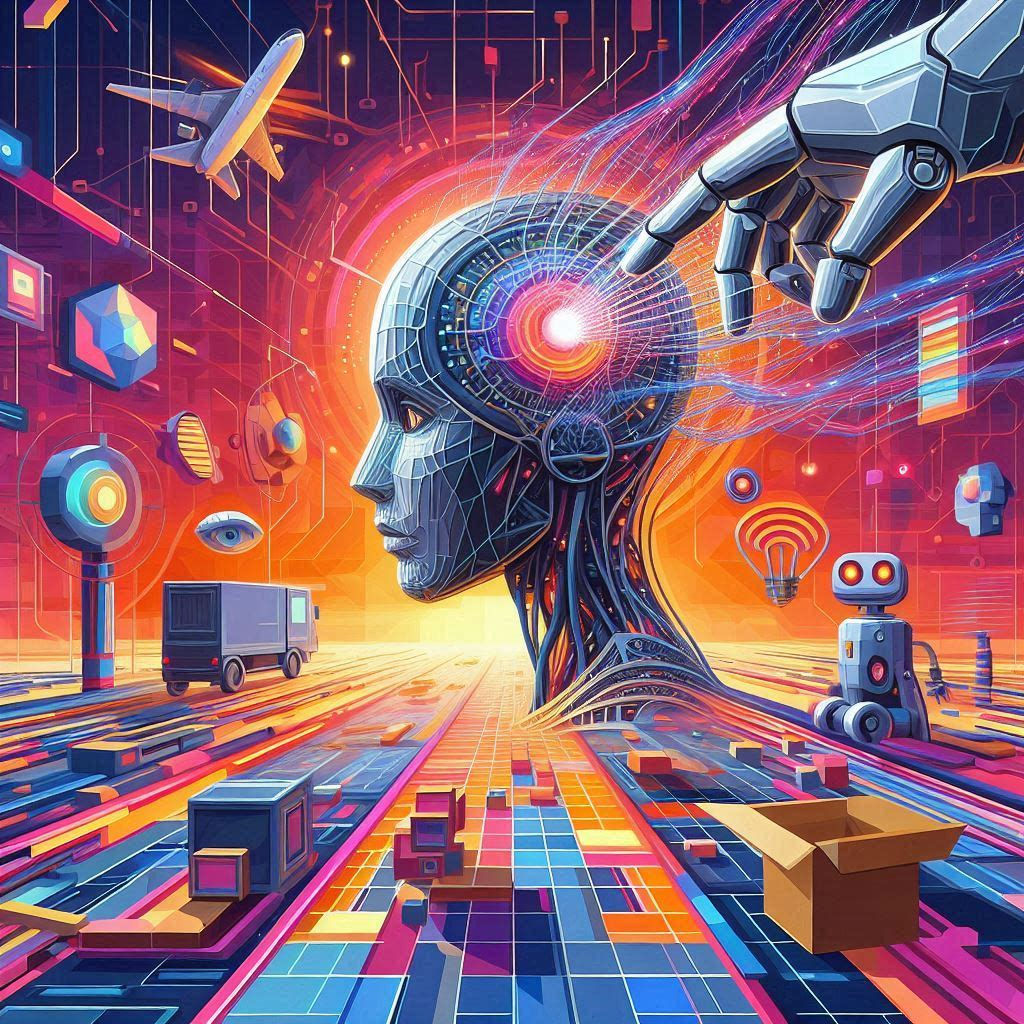Artificial Intelligence (AI) has been a transformative force in multiple industries, but perhaps has the longest history as part of smart home technology, revolutionizing how we interact with – and are protected by – our living spaces. To understand where this is all going, let’s review how AI got us here.
Understanding the origins of Artificial Intelligence
The term “Artificial Intelligence” was coined by John McCarthy in 1956 during the Dartmouth Summer Research Project. At the dawn of computing, long before the advent of personal computers or smartphones, this group aimed to explore “thinking machines” and investigate if future computers could exhibit intelligent behavior. The workshop was based on the idea that “every aspect of learning or intelligence could be described so precisely that a machine could simulate it.” This was truly a search for “artificial” intelligence that simply copied our own problem solving styles.

Their vision to develop machines with intelligent capabilities led to the birth of early AI concepts, focusing on areas like problem-solving, logical reasoning, and language translation. Over time, these foundational developments paved the way for the evolution of AI technologies that are now omnipresent in our daily lives.
Probably not such a good choice of words
However, the term “Artificial Intelligence” can be intimidating. People often associate “artificial” with something negative, as seen in the preference for natural ingredients over artificial sweeteners. Similarly, AI is often perceived as competing with a human’s “natural intelligence.” A more accurate perspective is to view AI as a tool that enhances human capabilities, much like a wrench amplifies human muscle.

The entire Industrial Revolution was marked by humans harnessing the power of nature and the creation of new machines to provide humanity with “Mechanical Advantage” that helped us improve our lives.
In a similar sense, AI is being harnessed by humans to augment our own thinking, and in the process, freeing our brains for more important tasks. In the same way that machines enhanced our muscles, tools like an abacus, calculator and computer enhance our minds.

Remarkably, the combination of these technologies that augment our muscles and our brains has lead to the creation of new tools that transport us places we could never go on our own. Think about the car you drive, the airplane you travel in, or the spacecraft that allows humans to reach for the stars – none would be possible without powerful tools that augment our own physical and mental limitations.
To that end, some people think that terms like Augmented Intelligence or Automated Intelligence is a better way to express what AI is and does. Of course, companies like Apple have coined their own terms, such as “Apple Intelligence,” to describe their AI initiatives in less scary terms. You can read more about Apple Intelligence here.
AI is Already in Your Home Today
While the history of artificial intelligence traces back to the mid-20th century when the concept of creating machines capable of performing tasks that typically require human intelligence first emerged, today, the integration of AI into smart homes is revolutionizing the way we interact with our living spaces. These tools actively enhance our convenience, comfort, and efficiency while freeing us from having to worry about the many details required to make our homes safe and secure.
In many ways the home security and home automation industry is an example of this augmented intelligence. Property owners pay security companies to handle concerns they can’t – or don’t want to – manage themselves. It’s natural for this industry to leverage AI across various workloads, so below we list a few uses of AI in today’s smart and safe home. These intelligent systems utilize natural language processing and machine learning algorithms to understand and respond to human requests, thereby simplifying everyday tasks and creating a more intuitive living environment.
- Voice Assistants: Devices like HomePod with Siri, Amazon Alexa and Google Assistant use AI to understand and respond to your voice commands. These AI-powered virtual assistants decode your request; send a specialized request to the cloud; package up the answer; and convert those digital signals to a human sounding voice – all in the blink of an eye. These tools have become household staples, allowing users to control various home devices with voice commands, set schedules, and even seek personalized recommendations. Soon, with new AI skills, they will be conversational and understand your intent.
- Facial Recognition: Security panels equipped with AI can identify faces and confirm that the person who is using their personal unlock code is actually the person entitled to do so. This might come in handy in the event someone steals or even guesses someone’s alarm disarm code – automatically sending you or the authorities a message that the face and the code used don’t match.
- Smart Cameras: Modern cameras use AI to detect activities inside or outside the perimeter of a home. Historically, most cameras were designed to send a live video signal to a human in a monitoring center to intercept a bad actor while a crime was being committed. Over time these same cameras began to record what was captured onto a video tape, then on a hard disk drive, and then to the cloud; to review after the criminal perpetrated the crime, because human guards were expensive and thefts were rare. Now, thanks to AI, cameras powered with Perimeter Guard or AI Deterrence features watch these camera feeds in real time, talking to the evil-doer (using the camera’s speaker) before they can perpetrate their intended action.
- Predictive Analytics/Insights Engine: AI never sleeps, so can easily analyze data patterns and provide insights or predict future outcomes. For example, your front door sees a lot of activity on weekday mornings, as you and your family leave for work and school. On weekends, however, you might not typically open it until later. So—if your front door opened early on a Saturday morning—you’d get an unexpected activity notification, indicating that your kids are likely exploring the front yard. AI power these alerts, and by processing the data generated by your connected smart devices, it’s able to learn your family’s unique activity patterns, discern unusual activity, and then act quickly on your behalf to address a potential problem.
- Energy Management & Predictive Maintenance: AI algorithms in smart thermostats adapt to users’ behaviors and by learning from manual adjustments and occupancy patterns, these devices create a customized schedule that aligns with users’ preferences, ensuring comfort without unnecessary energy consumption. AI also optimizes energy use and predicts maintenance or pending HVAC issues for home and business owners.
- Health Monitoring: AI-powered wearables are emerging as integral partners in users’ journeys toward better health. From optimizing fitness routines to aiding in the management of chronic diseases, these devices are at the forefront of a transformative health care experience. AI powered devices like Apple Watch actively track health metrics and provide insights into personal well-being, sometimes uncovering issues no human has been able to detect. This lead to a revolution known as wellness awareness beyond anything possible before AI.
The marriage of AI with smart home devices has revolutionized the way we interact with our living spaces. From smart thermostats that learn and adapt to your preferred temperature settings to security panels equipped with facial recognition capabilities, AI has elevated the functionality and intelligence of these devices to unprecedented levels. Home automation systems driven by AI can anticipate our needs, optimize energy usage, and provide a heightened sense of security, thereby transforming our traditional homes into intelligent, responsive ecosystems.
The Future of AI in Smart Homes
Looking ahead, the future of AI in smart homes promises to be even more transformative. As AI continues to advance, we can anticipate a new wave of smart home technologies that seamlessly integrate with our daily lives. Imagine a home environment where AI anticipates and adapts to our preferences, suggests energy-saving strategies based on our behavior, and even detects potential hazards before they occur. With the advancement of AI-driven predictive analytics and machine learning, smart homes will not only cater to our needs but also enhance our overall well-being and safety, redefining the very essence of modern living. We can expect that AI will make it possible for our homes to react to our spoken wishes, even if we can’t remember the magic phrase or wake word of the past. Furthermore, the integration of AI in healthcare monitoring within smart homes could revolutionize elderly care and enable proactive health management for individuals with specific medical conditions.

Challenges and Considerations
As we embrace the AI-powered intelligent home, it is crucial to address the potential challenges and considerations. Privacy and data security remain paramount concerns, as the interconnected nature of smart home systems brings forth the need for robust safeguards to protect sensitive information. One of the significant challenges in deploying AI in smart homes is ensuring privacy and security. As smart homes collect vast amounts of personal data, protecting this information from breaches is crucial.
Manufacturers must invest in robust security measures like encrypted communication channels and regular software updates. Make sure your smarthome vendor has a public and simple privacy pledge, like this one. Consumers should also take steps to secure their devices by using strong passwords and enabling two-factor authentication. Additionally, ensuring interoperability and standardization across AI-enabled devices will be essential in fostering a harmonious, seamless smart home experience for users.

The Journey Forward
The integration of AI into smart homes represents a significant leap forward in creating more intelligent and responsive living environments. The historical evolution of AI has set the stage for a future where smart homes epitomize connected living at its finest – and safest. Through the seamless integration of AI technologies, our homes are evolving into intelligent ecosystems that anticipate our needs, elevate our comfort, and enhance our well-being. The journey of AI in smart homes is an ongoing narrative of innovation, promising endless possibilities for the future of connected living.
